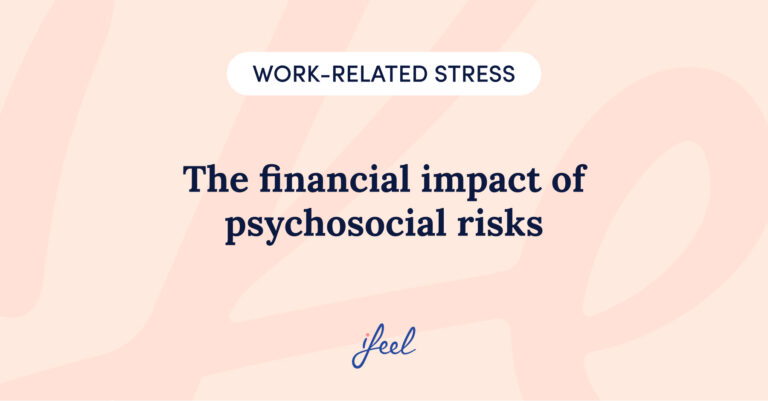Workplace negativity is related to what is known as “emotional contagion.” It is a simplified way of pointing out a very complex communicative process that frequently occurs between people: the mutual transmission of moods or the influence that the mood of others (and its expression through gestures, postures, and words) has on us and vice versa.
The risk of workplace negativity
Unless we are very enclosed within ourselves, absorbed in our thoughts or inner state, we are constantly exposed to being emotionally influenced by others and through contagious workplace negativity.
The attitude, verbal and non-verbal expressions, and gestures of the people around us, which manifest their emotions and feelings, impact us. The same thing happens to other people: they are somehow receptive to picking up what happens to us, even if they do not know exactly what it is or are not aware of it, and are influenced by it.

A normal emotional exchange
This emotional exchange is completely natural and inevitable. In a certain sense, it is an evolutionary achievement that we have developed within our repertoire of communicative and relational skills. Why? Because it is beneficial for living together and adapting to the environment we all have to share.
That is to say, being mutually permeable to our respective emotions is good for our survival. Imagine if we were unable to grasp – even without realizing it – part of the emotional world of the other and activate us from within, that is to say, move us accordingly. Imagine if the same thing were to happen to the other person when they are in front of us. We would function like robots! We would be incapable of noticing the other’s needs, helping them, or distancing ourselves from them if it is convenient, and our relationships would be tremendously poor.
Human beings have a highly developed ability to do this. So much so that, sometimes, in addition to capturing the emotions of others, we “catch” the emotional state of others, as is the case with workplace negativity. We change our emotional state by adopting the emotions felt by the person in front of us. That is to say, we adopt the emotion of the other person without choosing to do so, without wishing it or being able to avoid it. Some people are more susceptible to this happening, and others are less susceptible to it, but it happens to all of us to a certain extent.
This process, which we colloquially call “emotional contagion”, happens both with negative emotions (those that we experience as unpleasant), such as fear, anger, or sadness, and also with positive emotions (those that are pleasant to feel), such as joy, excitement or pride.
Suffering or enjoying other people’s influence
Sometimes we feel strange simply because others “change our mood” with their emotions. It can be for better or for worse. It is as if we say, “I have come to the office feeling so happy, and suddenly I’ve become discouraged with this bad vibe”, which would be a clear example of the influence of workplace negativity. The opposite can also happen: “I came here very unhappy, but seeing you all so happy helped me to get back on my feet”.
Thanks to this ability, we can arrive at work one day sad or discouraged but absorb the enthusiasm or optimism of those around us and temper our melancholy. Unfortunately, we can be happy in the office or neutral, and the complaining, irritable or impatient attitude of a colleague or boss can start to dampen our mood.
We often act – or become inwardly activated – by a reasonably automatic imitation mechanism, or we gradually identify with the other person’s emotions by being exposed to them, capturing and processing them even if we don’t want to.
Emotional influence and work environment
The truth is that there are people who act as natural emotional fuel for the team in such a way that they can instill emotions in others and modulate the work environment both positively and negatively. This aspect of the psychological dynamics at work is especially relevant when we want to foster healthy communication between colleagues or between bosses and employees.
This is often unavoidable, especially when the other person expresses their emotions intensely and constantly. In addition, we are particularly receptive that day, with that person, or with that particular emotion.
Taking responsibility for our emotional expression
Of course, when the mutual transmission of moods refers to positive emotions, everyone is happy and grateful, but it gets complicated with negative emotions.
If this happens, we all must take measures to avoid contributing to a hostile work environment. In other words, we must take responsibility for our emotions, especially those that can affect others negatively due to their negative or unpleasant nature.
Sometimes, if they are very intense or we are very obsessed with them, we cannot regulate them entirely and make them disappear. Still, we usually can moderate how we express them so that others do not absorb all that emotional “energy” and generate a bad atmosphere in the office.
5 tips to reduce workplace negativity
1. Be aware of our emotional expressions
To become aware of how we feel (the emotion itself) and how we express it outwardly. If our emotions are positive, they can contribute to a good atmosphere, but if they are negative, they will affect others and are not to blame. Being confident with others is fine, but it is important not to flood the work environment with our moods.
2. Differentiate ourselves from the other
Empathizing, being patient, and supporting or understanding are very positive elements for relationships between co-workers, but within limits that do not affect us. The fact that the other person feels down does not oblige us to feel down too. Knowing how to contain the power with which the other person’s emotion comes to me is necessary.
3. Put things into context
In summary, relativize. Do not give the other person’s emotions more importance than they have, nor think that the other person has a serious problem just because of what we interpret from their expressions, words, or tone of voice. Sometimes we overestimate things and worry about others more than they need.
4. Let’s try to interpret it well
Sometimes we assume that the other person is angry about one thing when they are angry about another, or we think they are sad when they are worried, or we think they are concerned about something when they are just physically tired. If we confide in them, we can ask them if they are worried about something or if there is anything we can do to make them feel better. Perhaps this will give us information, so we do not misunderstand what is happening to them and avoid getting caught up in the wrong emotion.
5. Be patient with our emotions and those of others
Human emotions follow logic, which is not always controllable, predictable, or understandable with objective criteria. Emotions arise with more or less reason for it, and we also transmit them to each other without being able to control or decide one hundred percent, as sometimes happens with workplace negativity. If we understand them from this point of view and give them their place, they end up being channeled into some action that dissolves them without having any more importance for the work team.
Improving emotional well-being in companies
Tackling workplace negativity is a task that may go unnoticed daily, but it is fundamental to avoid a toxic work environment and to maintain the cohesion of teams.
Our mission is to increase employees’ and their companies’ well-being at work. That is why we want to help them in the challenge of creating pleasant work environments where they can express themselves authentically but not in a way that is invasive to others. At ifeel, we strive to achieve this.
Our team of psychologists, experts in well-being at work, has created an emotional well-being program for companies that boosts talent retention, reduces absenteeism, and tackles employee stress. Thanks to our emotional well-being program, your company’s HR managers can receive personalized, data-driven advice on improving their teams’ psychological well-being. In addition, this program offers employees a 360° mental health care service structured at different levels according to their needs. Try our program now to see how it could help you.
Visit our Resources section, where you will find podcasts, guides for Human Resources, or interviews with leading HR professionals. In addition, you will have access to a Psychosocial Risk Factors Template, which will help you comply with the Labor Inspection requirements.
We hope you found this post about workplace negativity interesting. If you would like more information about our emotional well-being program for companies, simply request it, and we will contact your team as soon as possible.







